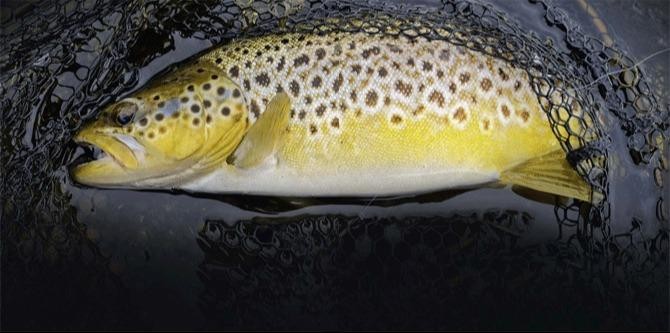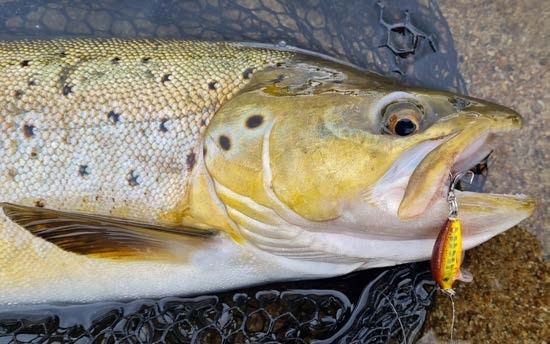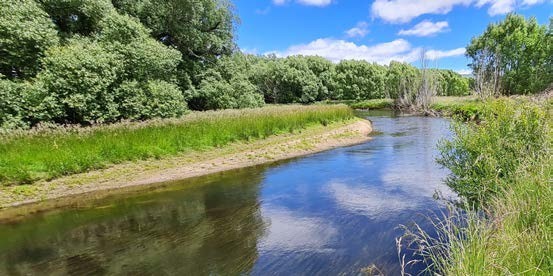Big Fish Eat Small Fish
By Greg Morton
On my most recent trout fishing trip I was shown in graphic terms that every angler should always ensure they have some ultra-light lures amongst their arsenal. And I mean really small lures. Soon after arrival at the mid reaches of the Taieri River I discovered that the river level had dropped considerably since my last visit. That was a major problem because it meant the weed level was now very close to the surface and made retrieving heavier lures a difficult proposition. Even my 7g spinners snagged weed virtually on every cast.

Greg has landed quite a few Taieri trout over the years that have blue colourations.
Faced with this problem, I considered going somewhere else or just struggling along, hoping to find deeper pools to target until I remembered I may have a solution on hand. The week previously I had thrown into my tackle box some long-neglected small Rapala minnows in case I struck shallow water. I didn’t use them that day, preferring spinners, but they were still in my bag.
Many years ago I purchased a small fishing publication put out by Rapala. The title is Trout: A True Challenge and it would have to be the most thumbed fishing book in my collection, full of detailed Rapala advice and tips. The New Zealand chapter was written by Don Hansen and he had recommended trying out the Rapala countdown wobbler CD1 in pocket water. Based on that information I had purchased several CD1s from America as this extremely tiny size is rare to source here.
Faced with the low water problem in front of me, I decided to go for broke and just use the tiddler minnows for the whole day. My decision was also influenced by the rod, reel and line I was using. All were ultra-light and extremely well-balanced.
How small is this lure? The CD1 is 2.5cm long (1”), 1/16th of an ounce in weight, and has a size #12 VMC treble on the back. The size of the hook was the main reason I had not previously used the minnows more often.
The Taieri River is dark, a factor caused by a weedy bottom and stained water. Some big brown trout and occasional perch live here. The slow flow means it is water well-suited to spin fishing. Trout seem to be concentrated in pockets so there is good and bad water even though it all looks very similar. Like a hunter I walk quickly past the non-productive spots and stalk slowly along the better spots.
The fishing technique employed was the following. Cast the brown/ yellow CD1 up and across and start winding immediately on splashdown. I varied this with casts straight up ahead of me. It skimmed back with that seductive Rapala wobble. Early on I had a couple of taps so I knew it was attracting attention.
River corners are prime spots and it was here I hooked up. The little CD1 landed near the far bank and was engulfed. I was still closing the bail arm. A big v-wave roared down the pool as the solid fish sought freedom. He fought deep, then when that failed jumped three of four times before tiring and allowing me to net him. He was a beautiful 1.75kg brown trout jack. I took a couple of photos while he was in the net then released him. Success had come as a total surprise but now I knew the local trout liked the look of this little fish.
More action came a few pools later and this magnificent warrior was the fish of the day. Once again the minnow was engulfed soon after the cast landed and he fought in a similar way to the first fish. All power whether in the air, down deep or while pulling line. The reason the small treble held so well was due to the manner each fish had hit the lure. They came from the back and half-swallowed what they thought was a small trout or cockabully. This jack trout was stunning and weighed 2kg. He was a rich gold colour, with numerous spots including a couple of blue ones on a gill plate. I have landed quite a few Taieri trout over the years that have this blue addition on their face. Each brown trout is just so unique.
The next trout was smaller but he went ballistic in the air and managed to snap the light leader. I had no more minnows of that colour so I had to use a brown trout colour pattern from then on. I lost two more trout in tough battles (one being a big bruiser) before finally late in the day hooking into a solid hen trout that I landed. Her body condition was incredible, and like the other two landed fish she sported a rich butter colour. She weighed 1.5kg and like the other two was released.
It had been a great day on the water and gave me plenty to think about for the future. I had hooked six trout and landed three. Five of the six hooked trout were big. The fish I hooked were in killing (not nibbling) mode, and in the case of the three landed had sucked in the whole minnow. Those that got off had gained their freedom through evasive efforts and one of them had broken the line.
The three landed were probably the largest trio of trout I have landed there in one session. Each was eye-catching in colour, fat, and full of fight. The bruiser that got off was even bigger, so in the case of this waterway big fish certainly eat small fish. It’s interesting to see how similar in colour the first little minnow was to the colour of the fish that ate him. He looked like a snack in their jaws.

1) The Rapala CD1 brought great success for Greg in the weedy, shallow water.

2) Tricky low-water conditions on the Taieri River.